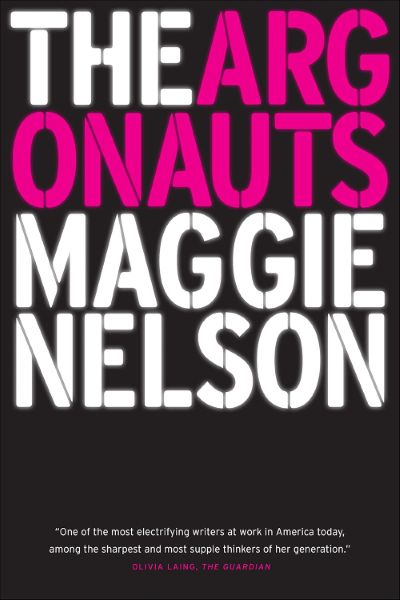The Argonauts
Contemporary queen of memoir-theory fusion Maggie Nelson turns her lens on identity, desire, and family. This instant classic recounts Nelson's relationship with her partner, artist Harry Dodge. Through intimate documentation of family life and pregnancy, Nelson presents a complex portrait of modern queer motherhood with blurred boundaries.

📝 Book Review
At the intersection of contemporary American literature and queer theory, Maggie Nelson’s “The Argonauts” shines like a luminous star, redefining through its unique style and profound thinking what memoir, theory, and love writing can be. Published in 2015, this work breaks traditional genre boundaries, fusing personal narrative, philosophical speculation, literary criticism, and political analysis into an entirely new form of writing, providing precious text for understanding 21st-century queer life, transgender experience, and radical intimacy.
Nelson explores the complexity of identity, body, desire, and family by documenting her relationship with transgender artist Harry Dodge and her own experiences of pregnancy and becoming a mother. The title “The Argonauts” comes from Roland Barthes’s metaphor: the Argo ship constantly replaces parts during its voyage, eventually every component is replaced, yet it’s still called the same ship. This metaphor perfectly captures the fluidity of identity and relationships—how we maintain certain continuity through constant change.
Seamless Fusion of Theory and Life
The most striking feature of “The Argonauts” is its ability to seamlessly fuse high theory with everyday life. Nelson doesn’t discuss queer theory or gender studies abstractly but embodies and tests these theories through her own life experiences. She cites theorists like Judith Butler, Deleuze, and Eve Sedgwick, but these citations aren’t decorative—they’re organically interwoven with her personal narrative.
For instance, when Nelson describes Harry’s testosterone injections and top surgery, she not only documents physical changes but contemplates how Butler’s theories of gender performativity unfold in real life. When she becomes pregnant, she explores the tension between Lee Edelman’s “antisocial” queer theory and her choice to procreate. This dialogue between theory and practice makes abstract concepts tangible and felt.
Nelson’s writing method challenges traditional boundaries between academic and personal writing. She proves that serious intellectual exploration can be tender, that personal stories can be theoretical. This fusion isn’t merely stylistic innovation but epistemological breakthrough—it suggests knowledge comes not only from abstract thinking but also from embodied experience.
Queer Temporality and Family Construction
“The Argonauts’” exploration of “queer temporality” is particularly brilliant. Traditional life narratives often follow linear progression: birth, growth, marriage, children, aging, death. But Nelson presents a different temporal experience: Harry’s transition process occurs simultaneously with her pregnancy, creating unique temporal overlap—one body masculinizing while another gestates life.
This temporal complexity challenges traditional family narratives. Nelson and Harry’s family isn’t simply defined by blood or law but continuously constructed through choice, desire, and commitment. Their family includes Nelson’s stepson, their child together, former partners, chosen kin. This family form embodies queer theory’s concept of “chosen family,” but Nelson’s description avoids idealization, honestly presenting difficulties and contradictions within.
Nelson particularly attends to how queer families navigate a heteronormatively structured world. From hospital forms to school activities, from legal documents to daily conversations, she details how institutions presume and reinforce traditional family models, and how queer families creatively respond to these challenges.
Language’s Limitations and Possibilities
As a poet and critic, Nelson possesses acute linguistic awareness. “The Argonauts” deeply explores language’s limitations and possibilities when expressing non-normative experiences. She contemplates the politics of pronouns—what does it mean when Harry chooses “he” pronouns? How does language shape and limit our understanding of gender?
Nelson quotes Wittgenstein’s famous line: “The limits of my language mean the limits of my world,” yet her writing practice constantly challenges these limits. She creatively uses language to describe experiences traditional vocabulary cannot capture: transgender bodily sensations, queer forms of desire, non-binary modes of existence.
The book’s discussion of “unspeakable love” is particularly moving. Nelson explores how queer love is often deemed “unnameable,” but she refuses to accept this silence. Instead, she uses rich, delicate, creative language to describe her relationship with Harry, proving that even within language’s limitations, love can still be expressed and witnessed.
Bodies’ Materiality and Fluidity
“The Argonauts’” description of bodies is both material and theoretical. Nelson doesn’t shy away from concrete bodily details: hormone effects, surgical scars, pregnancy discomfort, labor pain. But these descriptions are never mere physiological records—they’re always connected to larger questions of meaning.
Harry’s bodily transformation process is described both clinically and poetically. How testosterone changes voice, body hair, muscle distribution; how top surgery reshapes chest contours; how these changes affect self-perception and others’ perceptions. Nelson’s descriptions avoid the trap of exoticizing or medicalizing trans bodies, instead presenting them as a form of human experience—unique but not abnormal.
Simultaneously, Nelson’s own pregnant body undergoes dramatic changes. She describes pregnancy’s bodily sensations: organ displacement, skin stretching, hormonal fluctuations. These two simultaneously changing bodies create a dialogue about what’s “natural,” what’s “artificial,” and whether this distinction is meaningful.
Queering Motherhood
“The Argonauts’” exploration of motherhood is among its most innovative aspects. Nelson refuses traditional motherhood narratives—whether conservative “maternal instinct” discourse or certain feminisms’ wholesale rejection of motherhood. Instead, she presents a queered motherhood: acknowledging the bodily realities of procreation and nurturing while refusing to essentialize or sanctify them.
Nelson candidly describes her ambivalent feelings about pregnancy: anticipation and fear, connection and alienation. She explores the tension between queer theory’s traditional suspicion of procreation—Lee Edelman’s “no future” thesis, critiques of “reproductive futurism”—and her own choice to become a mother.
More importantly, Nelson demonstrates how motherhood can be queer. Her mothering practice doesn’t follow traditional scripts: her partner is transgender, her family structure is non-traditional, her parenting challenges gender norms. This queer motherhood isn’t simple negation of traditional motherhood but creative reimagining.
Politics and Ethics of Love
At “The Argonauts’” core is profound contemplation of love. Nelson explores how love is simultaneously personal and political, private and public. Her relationship with Harry isn’t merely emotional connection between two people but challenge to heteronormative society and exploration of new forms of intimacy.
Nelson particularly attends to questions of “recognition.” In a world that often denies or misrecognizes queer relationships, being seen, acknowledged, and respected is political. She describes the micropolitics of daily life: how to fill out relationship status on forms, how to introduce partners to others, how to respond to others’ misunderstanding or prejudice.
But Nelson also explores love’s ethical dimensions. She contemplates how to remain open to the other in relationships, how to maintain difference within intimacy, how to preserve freedom within commitment. She cites Levinas on the ethics of otherness, exploring how love requires us to face and respect the other’s fundamental alterity.
Formal Innovation in Writing
“The Argonauts’” formal innovation is as important as its content. Nelson employs a fragmented narrative structure, with short paragraphs arranged like verse, thoughts and images jumping and resonating between them. This form reflects queer experience’s non-linear character and embodies the actual process of thinking and feeling.
The book uniquely uses marginal notes to mark citation sources rather than traditional footnotes or endnotes. This design allows other voices—theorists, poets, friends—to appear directly on the page, juxtaposed with Nelson’s voice. This creates a sense of dialogue, suggesting thoughts and experiences always form in relation to others.
Nelson’s prose style fuses different linguistic registers: academic, poetic, colloquial, intimate. She can jump from Heidegger’s ontology to specific details of diaper changing within a paragraph. This stylistic mixing breaks hierarchical distinctions between high and low, theory and practice, thought and emotion.
Complex Stance on Normativity
“The Argonauts” takes a complex and nuanced stance on normativity. Nelson critiques heteronormativity while refusing simple anti-normative positions. She acknowledges that certain seemingly “normative” desires—like marriage, children—can also be authentic and valid, even for queer subjects.
Nelson particularly criticizes purist tendencies in certain queer theories that view any approach to normativity as betrayal. She argues this stance can become another form of normativity—an “anti-normative normativity.” Instead, she advocates for more flexible and inclusive queer politics allowing diverse lifestyles and choices.
This stance is particularly evident when discussing marriage. Nelson and Harry choose to marry, but she analyzes this decision’s complexity in detail: legal benefits versus political critique, personal desire versus collective politics, symbolic meaning versus practical impact. She refuses to view marriage simply as assimilation or liberation but sees it as a field full of contradictions.
New Directions for Trans Narratives
By documenting Harry’s story, “The Argonauts” provides new possibilities for trans narratives. Nelson avoids clichés of traditional trans narratives: no “trapped in the wrong body” language, no linear “transition” story, no final “becoming true self” ending.
Instead, Harry’s gender is presented as ongoing process rather than fixed destination. Nelson describes how Harry negotiates different gender expressions, responds to others’ recognition and misrecognition, adjusts gender performance in different contexts. This description acknowledges gender’s complexity and fluidity.
Importantly, Nelson writes from her position as partner rather than attempting to speak for Harry. She records her observations and feelings while always acknowledging the unknowability of Harry’s experience. This stance avoids the danger of possessing or colonizing trans experience.
Ethics of Intimacy
“The Argonauts” deeply explores ethical questions of intimate relationships. Nelson contemplates responsibility when writing about others, particularly when writing such intimate relationships. How can she tell her story without violating Harry’s privacy? How can she be honest without causing harm?
Nelson’s solution isn’t to avoid these difficulties but to incorporate them into the text itself. She openly discusses ethical dilemmas in the writing process, including Harry’s reactions to certain passages and their negotiations. This transparency is both ethical and aesthetic—it makes the writing process itself part of the text.
The book also explores power dynamics in intimate relationships. Nelson acknowledges her cisgender privilege, contemplating how this affects her relationship with Harry. She also explores how other forms of difference—race, class, age—operate in intimate relationships.
Literary Genealogy and Influence
“The Argonauts” dialogues with rich literary and theoretical traditions. Nelson explicitly cites her influences: Roland Barthes’s “A Lover’s Discourse,” Susan Sontag’s diaries, Eve Sedgwick’s queer theory, Judith Butler’s gender theory. But she doesn’t simply apply these theories—she tests and extends them through her own experience.
Nelson also dialogues with other writers exploring queer life: Audre Lorde, Samuel Delany, Eileen Myles. Her writing continues traditions these writers pioneered, exploring political and theoretical questions through personal narrative.
Simultaneously, “The Argonauts” opens new writing possibilities. It has influenced a generation of new writers similarly attempting to break genre boundaries, fuse personal with theoretical, explore queer and trans experiences.
Critique and Controversy
“The Argonauts” has sparked critique and controversy. Some critics argue Nelson’s perspective is too personal, lacking sufficient attention to structural inequality. Does her relatively privileged position—white, highly educated, economically stable—limit her understanding of queer experience?
Others criticize Nelson’s use of certain theories as oversimplified or selective. Does she fairly present the theoretical positions she critiques? Is her refutation of “antisocial” queer theory sufficient?
Questions about privacy and consent have also been raised. Despite Nelson’s efforts to protect Harry and family privacy, do ethical issues remain in making such intimate details public?
Reception and Impact
Despite these critiques, “The Argonauts” has received widespread acclaim and influence. It won the National Book Critics Circle Award and was named book of the year by major media including The New York Times. More importantly, it has deeply touched many readers, particularly those who cannot find their experiences in mainstream narratives.
For many queer and trans readers, “The Argonauts” provides a sense of being seen and understood. It proves non-normative lives and relationships can be presented beautifully, complexly, with dignity.
In academia, “The Argonauts” is widely discussed and cited. It provides new theoretical resources and methodological insights for fields including queer theory, trans studies, and life writing.
Continuing Contemporary Significance
As LGBTQ+ rights face new challenges, “The Argonauts’” significance becomes more pronounced. It reminds us that queer life’s complexity and richness cannot be reduced to political slogans or identity categories. It demonstrates the possibilities and difficulties of establishing and maintaining queer families in hostile environments.
The book’s attention to language and naming is particularly relevant in current debates about pronouns and gender identity. Nelson shows how language can both oppress and liberate, how it requires constant negotiation and innovation.
“The Argonauts” also provides a model for contemporary life writing. In an era of “autofiction” and “theory fiction,” Nelson’s work demonstrates how to combine personal experience with intellectual exploration, creating texts both intimate and universally meaningful.
Love and Change’s Persistence
Ultimately, “The Argonauts” is a story about love’s persistence through change. Like the Argo ship, Nelson and Harry’s relationship constantly changes—bodies transforming, family expanding, understanding deepening—yet something core remains unchanged. This isn’t static sameness but dynamic continuity.
Nelson’s writing itself embodies this paradox: by precisely recording specific moments and feelings, she captures something transcending time. “The Argonauts” reminds us that true intimacy doesn’t require the other to remain unchanged but continuing to choose each other through change.
Today, “The Argonauts” continues inspiring and challenging readers. It refuses simple answers, fixed categories, final conclusions. Instead, it invites us into an ongoing exploration process, an endless voyage about identity, desire, family, and love. In this sense, each reader becomes an Argonaut, participating through reading in this collective imagination of what possible life can be.
Book Info
Related Topics
🛒 Get This Book
 Buy on Amazon
Buy on Amazon Related Books
Book Discussion
Share your thoughts and opinions on this book and exchange insights with other readers
Join the Discussion
Share your thoughts and opinions on this book and exchange insights with other readers
Loading comments...


